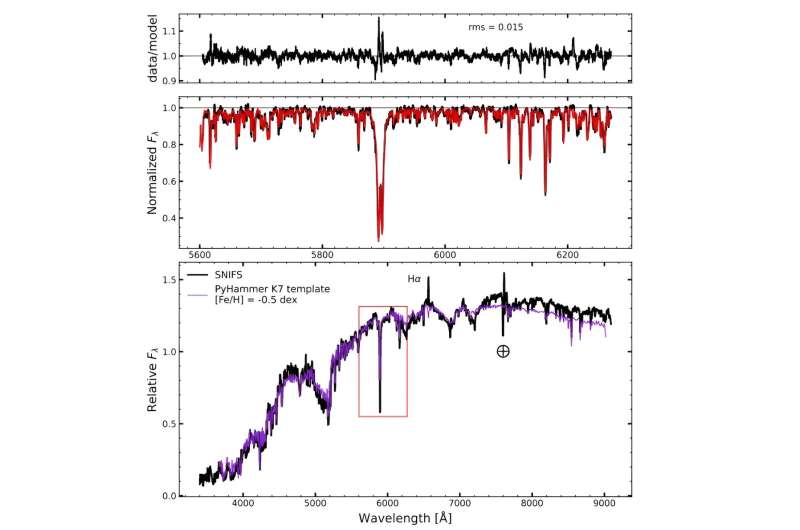August 5, 2024 report
This article has been reviewed according to Science X's editorial process and policies. Editors have highlighted the following attributes while ensuring the content's credibility:
fact-checked
preprint
trusted source
proofread
LAMOST J2354 binary hosts an unseen massive white dwarf, study suggests

Astronomers from the Ohio State University (OSU) and University of Hawai'i have performed spectroscopic observations of a recently-discovered binary system known as LAMOST J2354, which contains a dark companion star. Results of the observational campaign, presented July 26 on the pre-print server arXiv, suggest that the unseen object is a massive white dwarf.
Discovered in 2023, LAMOST J2354 consists of a K dwarf orbited by an unseen companion every 0.48 days. The primary star is estimated to have a mass of about 0.7 solar masses, while the companion object is assumed to be a neutron star about 40–60% more massive than the sun. The system is located some 416 light years away.
In order to shed more light on the properties of LAMOST J2354 and to unveil the nature of the companion object, a team of astronomers led by OSU's Michael Tucker decided to conduct follow-up high- and low-resolution spectroscopic observations of this system. For this purpose, they employed the University of Hawaii 2.2-meter telescope and the Large Binocular Telescope (LBT).
"We presented follow-up spectroscopy of the enigmatic binary LAMOST J2354 to better understand the K dwarf and its unseen, massive companion," the researchers wrote in the paper.
The observations found that the K dwarf is about 35% smaller and less massive than the sun. The obtained spectra revealed that the star has a metallicity at a level of -0.48 dex, with no peculiar chemical abundances.
Based on the collected data, the astronomers estimate that the mass of the companion object is most likely 1.3 solar masses and its minimum mass was derived to be 1.23 solar masses. The orbital separation between the two objects was measured to be 3.3 solar radii.
According to the authors of the paper, the obtained parameters of LAMOST J2354, together with the chemical abundance of the K dwarf, indicate that the unseen companion is a massive white dwarf. They disfavor the scenario in which this object may be a neutron star born from a core-collapse supernova.
"We find that a massive white dwarf with a cooling age of ≳ 3 Gyr satisfies all observational constraints," the researchers conclude.
Given the unseen white dwarf is too massive to have a pure helium core, the astronomers note that the system likely experienced two phases of common-envelope (CE) evolution. During these phases, the white dwarf progenitor began hydrogen-shell and helium-shell burning.
The scientists add that LAMOST J2354 will almost certainly experience another phase of mass-transfer in the future when the K dwarf evolves off of the main sequence, resulting in stable mass-transfer and the formation of a cataclysmic variable.
More information: M. A. Tucker et al, Weighing The Options: The Unseen Companion in LAMOST J2354 is Likely a Massive White Dwarf, arXiv (2024). DOI: 10.48550/arxiv.2407.19004
Journal information: arXiv
© 2024 Science X Network





















